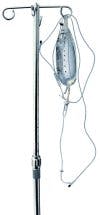Answering your questions Blood cultures collected from IV line, updating equipment and color atlas for urinalysis
Answering your questions Blood cultures collected from IV line, updating equipment and color atlas for urinalysis
Blood cultures collected from IV line
Q: Is there a reference describing
how to collect blood cultures aseptically from indwelling intravenous lines? Should the same blood culture contamination rate threshold be applied to line draws as for those collected by venipuncture?
A: Draws from vascular access
devices (VADs) like arterial lines, central venous catheters and heparin locks are notorious as sources for contamination from colonized bacteria.1-3 Because these ports pass through the skin and can remain for long periods of time, bacteria tend to accumulate in and around these invasive ports (colonization) and can be pulled into blood specimens drawn from them. Because of this tendency, at least two texts discourage their use for blood culture collection.4,5
However, because these devices offer direct access to the circulatory system without the necessity for a venipuncture, collectors are often tempted to use them for two reasons because an accessible vein can be difficult to find for venipuncture in critical patients, and to save the patient from the discomfort of venipuncture. Unfortunately, the latter reason, although well intended, is often invalidated because blood drawn through VADs often results in hemolysis or blood culture contamination, both of which necessitate a venipuncture, forcing unnecessary delays in testing.
The American Society of Microbiology sets the maximum acceptable contamination rate at 3 percent.7 This is an overall rate and includes blood cultures drawn by all methods and cultures positive because of colonization. Whether or not a more tolerant contamination rate should apply for cultures drawn from VADs is up to the facility. Arguments can be made either way. Because colonization is a variable that cannot be removed, it may be prudent for a facility to undertake a study to determine the percentage of blood cultures drawn from VADs that are positive due to colonization, i.e., those that are accompanied by negative cultures drawn by venipuncture. If the percentage of colonization exceeds
3 percent, it may justify a more tolerant threshold. Only gram-positive cultures should be considered, however, since studies show that gram-negative cultures obtained through arterial lines not confirmed by venipuncture may reflect true bacteremia.8
Dennis Ernst, MT (ASCP)
Director
The Center for Phlebotomy Education Inc.
Ramsey, IN
References
- Bryant J, Strand C. Reliability of blood cultures collected from intravascular catheter versus venipuncture. Am J Clin Pathol. 1987;88:113-116.
- Tonnesen A, Peuler M, Lockwood W. Cultures of blood drawn by catheters vs. venipuncture. JAMA. 1976;235:1877.
- Vaisanan I, Michelsen T, Valtonen V, et al. Comparison of arterial and venous blood samples for the diagnosis of bacteremia in critically ill patients. Crit Care Med. 1985;13:664-667.
- Garza D, Becan-McBride K. Phlebotomy Handbook. 5th ed. Stamford, CT: Appleton & Lange; 1999.
- Ernst D, Ernst C. Phlebotomy for Nurses and Nursing Personnel. Ramsey, IN: HealthStar Press; 2001.
- Policies and procedures for infusion nursing. Intravenous Nurses Society. Cambridge, MA; 2000.
- Weinbaum FI, Lavie S, Danek M, Sixsmith D, Heinrich G, Mills S. Doing it right the first time. Quality improvement and the contaminant blood culture. J Clin Micro. 1997;35(9):563-565.
- Levin P, Hersch M, Rudensky B, et al. The use of the arterial line as a source for blood cultures. Intensive Care Med. 2000;26:1350-1354.
When should equipment be updated?
Q: Is there an equation or rule
of thumb for determining when you have outgrown a chemistry analyzer and to help identify and justify an upgrade to administrative folks? Theoretical throughput seems to be only helpful to broadly categorize analyzers.
A: I am not aware of any equationto use in deciding when it is time to replace a chemistry (or any other) analyzer. A number of factors must be considered in making the decision to change instrumentation, since there will be a variety of costs associated with making the change besides that of the new equipment. There will be a need to evaluate appropriateness of current reference ranges for new instrument and possible reference range studies, training costs for staff, costs of computer changes including interface software and possible reprogramming to accommodate different reference ranges. In my opinion, the three major factors that should be considered in deciding when it is time to upgrade are inability to provide reliable service in a cost-effective manner; inability to meet turnaround time needs or handle workload; and need to consolidate testing from several instruments.
If you have extensive downtime for repairs or high repair costs, your instrument may no longer be operating in a cost-effective manner. With prolonged downtime, you are losing productivity from your employees and increasing the costs of producing laboratory results. In addition, you may not be providing satisfactory service for your physicians. If you have been receiving complaints relating to problems of this type, you could document these to administration. You might also compare your total costs for maintenance to those of other laboratories. One source of such information is the Laboratory Management Index Program of the College of American Pathologists.
Another important factor in deciding to upgrade instrumentation is a change in workload that has exceeded the capacity of your instrumentation. This may prevent you from meeting your turnaround time goals. While it is correct that theoretical throughput represents an ideal volume of testing that can be handled, it is possible to get an estimate of the workload needs of your laboratory by studying the pattern of workflow coming to your laboratory. This should include total workload per shift, as well as peak workload per hour. In the traditional hospital laboratory, peak workload typically occurred early in the morning. With laboratory consolidations and outreach efforts, and increasing emphasis in many hospitals on affiliating with physicians offices to provide laboratory work, peak workload may not be in the early morning, or may be similar throughout the day. If your laboratory has experienced such a change in workload, or is anticipating outreach efforts, you may be able to justify new equipment to handle the existing or anticipated increase in samples.
Finally, since the major cost of laboratory testing is for personnel, a laboratory could justify new equipment if it could consolidate testing from multiple instruments into a single platform and thus reduce the need for technical staff. In such a scenario, the laboratory would estimate the costs of new equipment against the savings derived from reducing laboratory staff. This type of approach is particularly useful for a healthcare setting where there is high turnover, lack of available individuals to fill vacancies, or a need to reduce expenditures overall. Many new instruments are becoming available that consolidate chemistry and immunoassay instrumentation into a single instrument interface. For large-volume laboratories, laboratory automation systems using track systems of various sorts can allow fewer operators to oversee multiple types of tests.
In addition to purchasing equipment, laboratories may also be able to obtain new equipment through cost-per-test agreements with manufacturers. The decision to buy or lease, such as with cost-per-test contracts, is based on total costs during the life of the contract, loss of availability of capital with purchase, finance costs, expected useful life of the instrumentation and plans to change equipment or workload in the near future. In many ways, the decision to buy or lease is similar to that with a car. Cost-per-test contracts are often less expensive, particularly when multiple laboratories group together to acquire similar instrumentation or combine contracts for multiple types of instruments, such as hematology, chemistry and coagulation. Since cost-per-test contracts do not require any purchase costs, they are often easier to sell to administration.
D. Robert Dufour, MD
Chief of Pathology
Veterans Affairs Medical Center
Washington, DC
Color atlas for urinalysis
Q: Do you know of a good color
atlas for urinalysis? Our lab is interested in obtaining one as a reference.
A: We recommend,
Ringsrud, KM and Linn JJ: Urinalysis and Body Fluids: A ColorText and Atlas, St. Louis, Mosby, 1995. The book is intended to serve as a reference manual and a textbook.
The textbook portion includes chapters on: regulations, safety and quality assurance, introduction to urinalysis, examination of physical properties of urine, chemical examination of urine, and microscopic examination of the urine sediment and body fluids.
Karen M. Ringsrud MT(ASCP)
Assistant Professor
Department of Laboratory Medicine
and Pathology
University of Minnesota Medical School
Minneapolis, MN
January 2003: Vol. 35, No. 1





